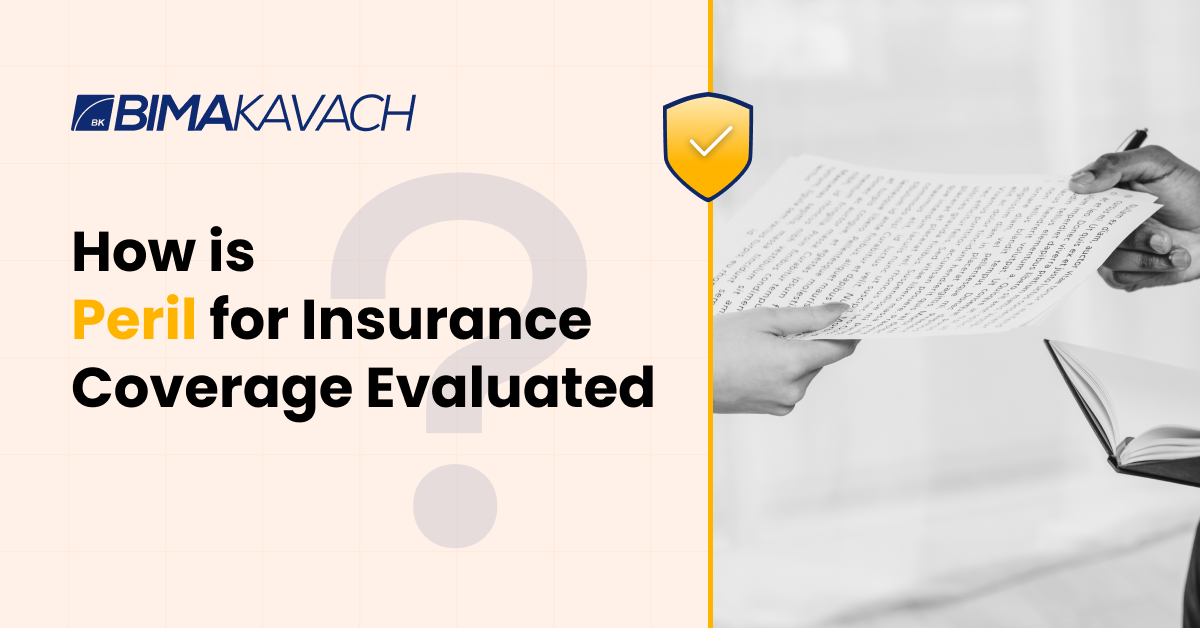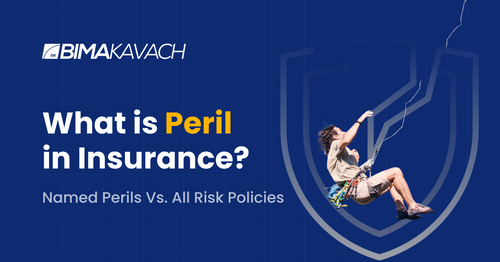Imagine you are on a vacation. You spend your time living life to the fullest. You have the best time of your life, but when you come back, you realize that your house has been robbed. All the fun of the vacation turns into a nightmare suddenly, losing all your hard-earned money overnight.
What I just described is an example of one of the perils of owning a home - theft. There are, similarly, several types of perils that surround us in our day-to-day lives. But what exactly is a peril? Well, let us discuss that in depth in this article. Let us also cover what the two types of perils are, how man-made and natural perils compare, and how these perils affect insurance coverage. In a world that is uncertain, and where life is fickle, it is essential to have an understanding of the dangers that surround us, and what are the proactive steps we can take to protect ourselves financially.
Definition of Peril in Insurance
A peril is a specific risk or cause of potential damage that an insurance policy covers. It includes a wide range of events or circumstances that might cause financial harm, including natural catastrophes (e.g., earthquakes, hurricanes), accidents (e.g., vehicle accidents), theft, fire, or other mishaps. Policyholders are protected against potential losses because insurers assess and price the policies based on the perceived risk associated with the perils they cover.
The risks covered by insurance policies are normally listed and defined, and the degree of coverage for each peril varies depending on the type of policy and its terms and conditions. Perils form the core of the insurance industry, as policies are designed to provide financial protection against the financial implications of these perils, thus, ensuring policyholders can recover from losses.
Categories of Perils
The specific perils covered by insurance policies can vary depending on the type of policy and the insurance company. These perils can be categorized into different types based on their nature and source of occurrence. It is essential to understand these different categories of perils, to choose the right policy. Some common categories of perils in insurance include:
1. Natural Perils: These are events caused by nature, such as earthquakes, floods, and hurricanes.
2. Man-Made Perils: These are risks originating from human actions, including theft, vandalism, and acts of terrorism. These perils are often covered under property and casualty insurance policies.
3. Accidental Perils: These involve unforeseen accidents leading to harm, such as car accidents or slip-and-fall incidents. These policies protect against the financial consequences of unintentional harm.
4. Fire and Allied Perils: This category covers damage due to fire, explosions, and related risks. Specialized insurance may cover some of these perils.
5. Liability Perils: These encompass legal risks, like lawsuits and liability claims, covered by liability insurance.
6. Economic Perils: These relate to financial or economic risks like stock market crashes, currency devaluation, and business interruptions. Commercial insurance policies may address these perils.
Get Free Quote in Minutes
Named Perils vs All-risk Policies
When it comes to specifying the perils in insurance policies, there are two primary categories - named perils and all-risk (comprehensive) policies. Let us understand these two categories in detail.
Named Perils Policies: These policies explicitly list the perils they cover. Policyholders know precisely which events or circumstances are protected. For example, a named perils policy for a business might specifically list fire, flood, and vandalism as covered perils. This type of policy offers transparency but may leave policyholders vulnerable to unlisted perils.
All-Risk Policies: All-risk policies provide broader coverage. They protect against all perils except those explicitly excluded in the policy documents. These policies offer comprehensive protection, making them more adaptable to unforeseen risks. However, they often come with higher premiums due to their extensive coverage.
Role of Peril in Insurance
In the world of insurance, the concept of peril is central to the design and coverage of insurance policies. Insurance policies are essentially contracts that outline the terms and conditions of coverage between policyholders and insurers. Perils - the exact events or circumstances against which the policy is intended to cover - are at the heart of these policies.
Insurance firms provide a variety of insurance types, each targeted to address particular perils. For example, a homeowner's insurance policy may explicitly cover perils such as fire, theft, and vandalism. An auto insurance policy is intended to safeguard the insured vehicle against risks such as accidents, collisions, and theft. Thus, depending on the specific needs of the policyholders, and the perceived risk of the perils, insurance firms can provide different insurance policies.

How is Peril for Insurance Coverage evaluated?
Assessing perils for coverage:
Insurers assess perils for coverage by considering essential factors. The location of the insured property is critical, as it determines the exposure to specific risks based on geography and climate. For example, coastal properties may face hurricane threats, while homes in fire-prone areas contend with different perils.
The type of property, whether it's a residence, vehicle, or business, significantly impacts the coverage needed. Each property type has its unique vulnerabilities, necessitating tailored insurance. Businesses may require liability coverage, while homes need protection against theft, fire, and natural disasters.
Insurers fine-tune policy conditions and terms to address these perils. This can involve adding endorsements for added protection or exclusions for specific risks. Through this meticulous evaluation, insurers create policies that align with the property's risk profile, ensuring policyholders have comprehensive coverage that effectively addresses potential hazards.
Effect of perils on policy premiums:
The presence or absence of specific perils plays a vital role in determining insurance policy premiums. Insurance companies consider the likelihood of a peril occurring and the potential cost of claims associated with it. If a property faces a higher risk of certain perils, such as flood or earthquake, the premium is likely to be higher to offset that risk. Conversely, if a peril is excluded from coverage, it can result in lower premiums. Insurers calculate premiums based on the overall risk profile of the insured property, including its susceptibility to various perils.
Risk vs Peril vs Hazard
Risk, peril, and hazard are commonly used terms in the realm of safety and insurance. Each of the three words has a distinct meaning and scope. Let us understand the 3 terms in detail.
Risk: Risk refers to the probability of an adverse event occurring, resulting in potential losses and damages to the policyholder. It's a measure of uncertainty about future outcomes, covering the chances of both positive and negative results.
Peril: Peril specifically identifies the cause or source of a danger or harm. It points to the events or circumstances that can lead to loss, damage, or injury. Examples of perils include fires, floods, earthquakes, accidents, or theft.
Hazard: Hazard refers to the conditions, situations, or factors that increase the likelihood of a peril resulting in harm or loss. Hazards can worsen the risk associated with a peril. For instance, a poorly constructed building in an earthquake-prone area is a hazard that increases the risk of earthquake-related damages.
With an understanding of the three terms in mind, the relationship between risk, peril, and hazardcan be understood as:
● Risk is the possibility of a loss.
● Peril is what causes a loss.
● Hazard is something that increases the possibility of a loss
Conclusion
Understanding the concept of peril in insurance is essential for navigating the complex world of financial risk management and insurance coverage. Peril represents the specific risks or causes of potential damage that insurance policies are designed to shield us from. It encompasses a wide array of events and circumstances, from natural disasters to man-made mishaps.
The type of peril and its presence or absence in a policy can significantly impact insurance premiums. Hence, individuals and businesses must select policies that align with their unique needs and risk-taking ability. By comprehending the nuances of peril, policyholders can make informed decisions, safeguard their financial well-being, and face an uncertain world with greater confidence.
Frequently Asked Questions:
1. What is peril? Explain with an example.
A peril is a specific risk or cause of potential damage that an insurance policy covers. It includes a wide range of events or circumstances that might cause financial harm. Examples are natural catastrophes (like earthquakes, and hurricanes), accidents(like vehicle accidents), theft, fire, or other mishaps.
2. What are some commonnamed perils?
Some commonly named perils include fire, lightning, windstorm, hail, explosions, theft, vandalism, riot or civil commotion, aircraft, vehicles, smoke, volcanic eruption, falling objects, weight ice, snow, or sleet, accidental discharge of water or steam, freezing of plumbing, and electrical damage.
3. How do you identify a peril?
A peril is either the direct cause of an accident or the source of a loss. For example, if a lightning strike damages your home, the lightning strike is considered a peril. If your house catches fire, fire will most certainly be regarded as a peril.
4. What is the benefit of all-risk policies?
All-risk insurance policies provide comprehensive and flexible coverage, reducing gaps and offering peace of mind. They simplify insurance, adapt to various needs, and are cost-effective when considering their inclusive protection. This versatility and simplicity make them an attractive choice for individuals and businesses seeking robust insurance coverage.

